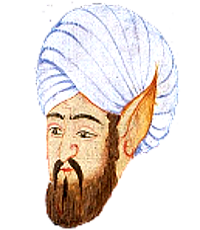4. The Muslim caliphates
After the death of the Prophet Muhammad in Medina in 632, his followers on the Arabian peninsula expanded quickly in all directions, creating an empire which only one hundred years later came to include not only all of the Middle East and much of Central Asia but North Africa and the Iberian peninsula as well. This was known as the “caliphate,” from khalifah, meaning “succession.” Yet it was difficult to keep such a large political entity together and there were conflicts regarding who should be regarded as the rightful heir to the prophet. Thus, the first caliphate was soon replaced by a second, a third and a fourth, each one controlled by rival factions. The first caliphate, the Rashidun Caliphate, 632-661, was led by the sahabah, the “companions” who were the family and friends of the prophet and who all were drawn from Muhammad’s own Quraysh tribe. The second caliphate, the Umayyads, 661-750, moved the capital to Damascus in Syria. And while it did not last long, one of its offshoots established itself in today’s Spain and Portugal, known as al-Andalus, and made Córdoba into a thriving, multicultural center.
The third caliphate, the Abbasids, 750-1258, presided over what is often referred to as the “Islamic Golden Age,” when science, technology, philosophy, and the arts flourished. The Abbasid capital, Baghdad, became a center in which Islamic learning combined with influences from Persia, India and even China. These achievements came to an abrupt halt when the Mongols sacked the city in 1258. From now on it was instead Cairo that constituted the center of the Muslim world. Yet the caliphs in Cairo too were quickly undermined, in this case by their own soldiers, an elite corps of warriors known as the Mamluks. The next Muslim empire to call itself a caliphate was instead the Ottoman Empire, with its capital in Istanbul, the city the Greeks had called Constantinople. Although the Ottomans were Muslims, they were not Arabs but Turks, and they had their origin in Central Asia, not on the Arabian peninsula.
Despite the continuing story of political infighting and fragmentation, the idea of the caliphate continues to exercise a strong rhetorical force in the Muslim world to this day. During the caliphates, the Arab world experienced unprecedented economic prosperity and a cultural and intellectual success which made them powerful and admired. Not surprisingly perhaps, the idea of restoring the caliphate is still alive among radical Islamic groups who want to boost Muslim self-confidence.















